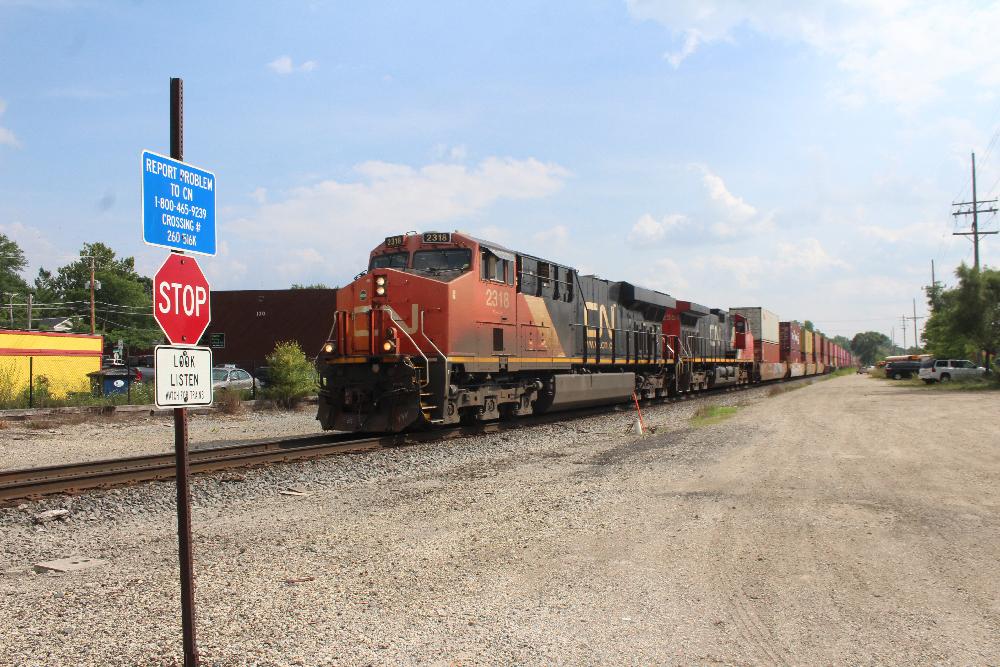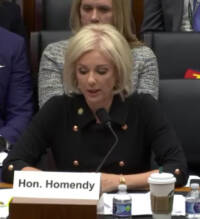
WASHINGTON — Although the House Transportation and Infrastructure’s Rail Subcommittee hearing Thursday was titled, “Oversight and Examination of Railroad Grade Crossing Elimination and Safety,” the 21/2-hour session also dealt with other issues. These included miles’ long trains, the state of wayside equipment detection, the pending mandatory crew-size rule making, and Class I railroads’ reticence to embrace the Federal Railroad Administration’s Confidential Close Call Reporting System.
Divergence from the main subject was a foregone conclusion, because the Committee’s minority Democrats have complained about the majority Republican leadership’s failure to schedule a rail safety hearing of any kind since the Norfolk Southern’s East Palestine, Ohio, derailment last February.
But one of the four witnesses, National Transportation Safety Board Chairman Jennifer Homendy, consistently kept lawmakers focused on the often-ignored topic of rectifying highway grade crossing challenges. Particularly powerful was the anecdotal evidence NTSB investigators discovered at the “passive” Mendon, Mo., crossing, that was the scene of the fatal Southwest Chief crash into a dump truck on June 27, 2022 [see “Design of crossing contributed to fatal Southwest chief accident, NTSB says,” Aug. 2, 2023].

Providing details in her written testimony, Homendy stressed that community outreach was an essential component in identifying crossings without active warning devices where roadway characteristics need to be modified. She lauded the Missouri Department of Transportation for establishing a $50 million program to do just that.
“We’d save so many lives if we could get people out of their cars and onto trains and transit systems,” Homendy observed.
The other witnesses were Federal Railroad Administration Administrator Amit Bose, Association of American Railroads President and CEO Ian Jeffries, and Indiana Department of Transportation Commissioner Michael Smith.
Bose explained that the Bipartisan Infrastructure Law’s Railroad Crossing Elimination Program grants will spend $3 billion over 5 years; the latest $570 million installment will address deficiencies at 400 crossings in 32 states. But the U.S. has 112,000 level crossings, and the FRA’s backlog of administrative tasks prevented a crossing grant offering in 2023. Bose said his agency would announce another funding opportunity in January.
Smith explained that Indiana’s state-funded Local Trax Rail Overpass Program grants has spent $125 million on 11 projects that will be completed by 2025. Eliminating two crossings with an overpass in Elkhart County, however, will cost $40 million. Homendy remarked, “It takes years to get crossings eliminated; we need to streamline the process.”
Long freight trains blocking crossings for an extended period was also a recurring topic. The FRA’s portal recorded 22,000 such complaints from motorists during the past year; 21% of them were in Texas. Reporting where the events occur has improved over the last several years because every crossing has a blue identifying sign and a phone number to call. Bose noted the agency has made a special effort to dissect problems in the Houston area, but used the discussion to point out that there is currently no regulation dictating train length and no data was collected on that until recently.
The FRA Administrator stayed away from linking blocked crossings and his agency’s pending rulemaking that would require two crew members on every train. The AAR’s Jeffries acknowledged that stalled trains hurt everyone, and carriers actively seek to eliminate the problem, but candidly made it clear, “we will fight the two-man rule hard.”
A number of the hearing’s GOP attendees read similar statements questioning the use of Consolidated Rail Infrastructure and Safety Improvement (CRISI) funds on anything but short line improvements rather than passenger rail projects. Others conflated competitive Federal State Partnership grants to the California High Speed Rail project with CRISI funding, accusing the FRA of taking money away from freight railroads. Bose assured the lawmakers that the short lines were getting a fair shake, passenger rail improvements invariably improve freight fluidity, and in California, much of the grant money helps keep high speed passenger and freight rail separated.
Here is a video of the proceeding, with more than two hours of lawmaker questioning and prepared witness testimony.














Sorry, last thing I want to see is another pair of bureaucratic agencies with power to fine private companies. Don’t trust ’em. Now if you want to fine anybody, how about the idiots that try to beat trains at crossings, run around lowered gates or get trucks stuck at an unsuitable crossing point.
Give the FRA and the NSTB fining authority and then their recommendations won’t be so hollow to the railroads. Its interesting that when the NSTB recommends changes to the airlines and plane manufacturers after an accident or incident, they most often make immediate changes to their processes and engineering so that the problem is remediated. But the railroads seem to think that these recommendations are optional, and why shouldn’t they when the FRA and the NSTB have no power to enforce their requirements. Give these two agencies power to enforce their requirements with commensurate fines in the millions and not the thousands and changes will occur more quickly and railroads will have to come to grips with their responsibility for the effect of their “monster” trains on the public. They have flown under the radar for far too long.